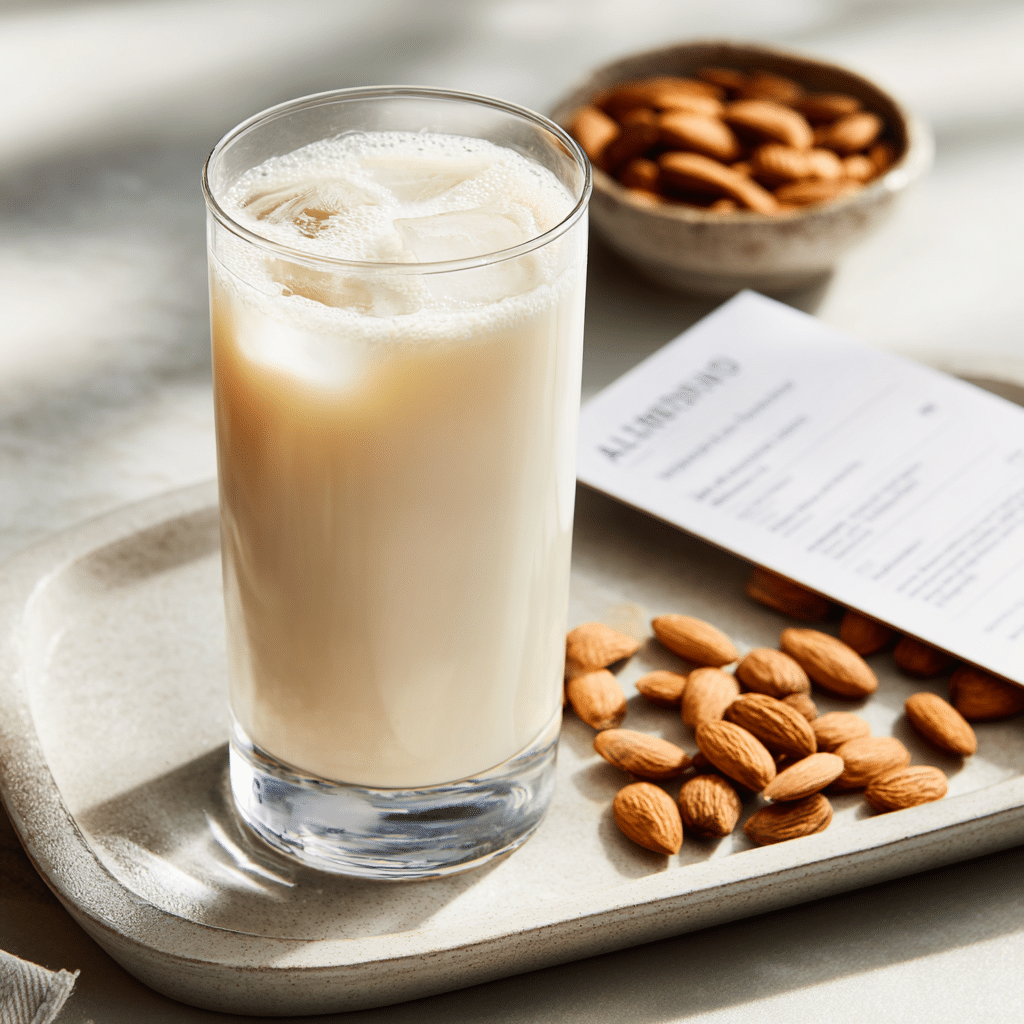Almond milk nutrition is one of the top reasons more people are choosing it over dairy. Whether you’re blending it into smoothies, pouring it over cereal, or using it in your morning latte, almond milk has become more than a trend—it’s a lifestyle shift. But what exactly makes almond milk nutrition so appealing? In this complete guide, we’ll explore the facts behind the label. From calories and vitamins to how it compares with cow’s milk, we’ll show you why almond milk nutrition continues to gain attention in homes across the U.S.
Table of Contents
Table of Contents
How Almond Milk Earned a Spot in My Fridge
The Day I Switched to Something Lighter
It started with coffee. I asked for almond milk instead of my usual whole milk—just to try something different. That single swap was all it took. It tasted smooth, lightly nutty, and balanced. I liked it more than I expected. I started thinking about almond milk nutrition and whether it could actually fit my daily routine.
Later, I picked up a carton and flipped it around to check the label. The almond milk nutrition facts were surprisingly simple: low in calories, no cholesterol, and added calcium. That sold me. Over the next few weeks, I started using it in smoothies, baking, and even in oatmeal. The more I used it, the more I realized I didn’t miss dairy.
Why Almond Milk Nutrition Matters
Almond milk nutrition isn’t just for people avoiding lactose. It’s now part of everyday meals for anyone trying to eat lighter or reduce animal products. What makes it stand out is how it manages to be low in calories while still offering key nutrients like vitamin D and calcium.
Most commercial almond milk brands, like Silk and Califia Farms, enrich their formulas with essential vitamins to support bone health. Some also keep their formulas clean—pure almond milk with no additives is now a common option for label-conscious shoppers.
Understanding almond milk nutrition helps you make better decisions about what goes into your body. It’s about more than skipping dairy—it’s about choosing something that works for your health and your lifestyle.

Silk Vanilla Almond Milk Smoothie
Ingredients
Method
- Add Silk vanilla almond milk, banana, strawberries, oats, almond butter, cinnamon, and vanilla extract into a blender.
- Blend until smooth and creamy, about 30–45 seconds.
- Add ice cubes if a thicker texture is preferred, and blend again.
- Pour into a glass and serve immediately.
Nutrition
Notes
Tried this recipe?
Let us know how it was!Want to save this smoothie for later? Pin it to your healthy breakfast board and follow us on Pinterest for more plant-based inspiration.
Almond Milk Nutrition Facts Explained
What’s Inside a Cup of Almond Milk?
Let’s take a closer look at almond milk nutrition by the numbers. Here’s a typical nutrition label for 1 cup (240 ml) of unsweetened almond milk, one of the most commonly used versions:
| Nutrient | Amount |
|---|---|
| Calories | 30–40 |
| Fat | 2.5g |
| Saturated Fat | 0g |
| Protein | 1g |
| Carbohydrates | 1–2g |
| Sugars | 0g (unsweetened) |
| Calcium | 450mg (45% DV) |
| Vitamin D | 2.5mcg (25% DV) |

These values may vary slightly by brand, but most commercial almond milks like Silk vanilla almond milk or store-brand unsweetened versions stay close to these numbers.
What stands out in almond milk nutrition is how low it is in calories and sugar. Many people turn to it as part of weight management or low-carb eating habits. Plus, with no cholesterol and minimal fat, it fits easily into heart-healthy diets.
Almond Milk vs. Cow’s Milk vs. Other Plant Milks
Here’s how almond milk nutrition stacks up against common alternatives:
| Milk Type | Calories | Protein | Calcium |
|---|---|---|---|
| Whole Milk | 150 | 8g | 275mg |
| Oat Milk | 120 | 3g | 350mg |
| Almond Milk | 30–40 | 1g | 450mg |
As you can see, almond milk nutrition is best if you’re watching calories or cutting down on animal fat. It’s not ideal for protein, but you can make up for that in other parts of your diet.
Who Should Drink Almond Milk—and When It Fits Best
Who Benefits Most from Almond Milk Nutrition?
Almond milk nutrition isn’t one-size-fits-all—but for many people, it checks the right boxes. If you’re lactose intolerant, following a vegan lifestyle, or managing calories, almond milk is a natural fit.
Here are a few groups who can benefit most:
- People with dairy sensitivity: Almond milk has zero lactose and no dairy protein. That makes it easy on digestion for those who struggle with bloating or discomfort from cow’s milk.
- Anyone watching their weight: With only 30–40 calories per serving, almond milk is a lighter choice than both whole milk and oat milk. It works well in low-calorie diets or fasting windows.
- Vegans or plant-based eaters: Almond milk nutrition gives you added calcium and vitamin D—two nutrients that can be harder to get without dairy. It supports bone health without animal ingredients.
That said, almond milk isn’t the best choice for everyone. If you’re focused on building muscle or need higher protein levels, you’ll want to pair it with protein-rich foods or consider fortified alternatives like soy milk.
When Is the Best Time to Use Almond Milk?
Almond milk is flexible. You can use it morning, noon, or night, but it shines in certain moments.
Here’s how almond milk nutrition fits into daily life:
- Morning smoothies: Its creamy, light texture makes it perfect for breakfast blends. Try it with oats, banana, and frozen berries for a filling meal.
- Coffee and tea: Almond milk froths well and adds a mellow flavor without overpowering your brew.
- Evening snacks: Because it’s low in sugar and fat, almond milk won’t spike your blood sugar before bed.

It’s also a great swap in baking or dairy-free pancake recipes where a hint of nutty flavor works.
Whether you’re drinking it straight or mixing it into a dish, almond milk nutrition adapts easily to your routine. Just make sure to shake the carton first—natural separation is totally normal!
Frequently Asked Questions About Almond Milk Nutrition
Is almond milk good for you?
Yes, almond milk is a healthy choice for many people. It’s low in calories and sugar, contains no cholesterol, and is often fortified with important nutrients like calcium and vitamin D. Almond milk nutrition makes it a smart alternative for those avoiding dairy or managing weight.
Does almond milk have protein?
Most almond milk contains about 1 gram of protein per cup. It’s not a high-protein option like soy milk or cow’s milk, so if protein is a priority, you’ll want to pair almond milk with other sources or choose a version that includes added pea or soy protein.
What are the health benefits of almond milk?
Almond milk nutrition supports bone health (thanks to added calcium), heart health (with no cholesterol), and digestive comfort (because it’s lactose-free). It’s also low in calories, which makes it popular for weight management or clean eating.
Is almond milk better than regular milk?
It depends on your needs. Almond milk nutrition is better if you’re cutting calories, avoiding dairy, or reducing cholesterol. Cow’s milk offers more protein but also more calories and saturated fat. For most people, almond milk is a great plant-based option.

Final Thoughts
Almond milk nutrition makes it easy to say yes to plant-based living. It’s light, versatile, and packed with benefits—especially when you choose unsweetened varieties with added nutrients. Whether you’re pouring it over cereal, blending it into smoothies, or sipping it with coffee, almond milk fits smoothly into a healthy routine.
It’s not about skipping dairy for the sake of a trend—it’s about choosing what works for your body and your goals.
Looking for ways to use almond milk in your kitchen? Don’t miss our practical guides on Silk vanilla almond milk nutrition for real-life tips and trusted recipes.
Have you tried this recipe? We’d love to see your version—share your photos or tips with us on Facebook.

